Yuxi Zhang
Gaussian Primitive Optimized Deformable Retinal Image Registration
Aug 23, 2025Abstract:Deformable retinal image registration is notoriously difficult due to large homogeneous regions and sparse but critical vascular features, which cause limited gradient signals in standard learning-based frameworks. In this paper, we introduce Gaussian Primitive Optimization (GPO), a novel iterative framework that performs structured message passing to overcome these challenges. After an initial coarse alignment, we extract keypoints at salient anatomical structures (e.g., major vessels) to serve as a minimal set of descriptor-based control nodes (DCN). Each node is modelled as a Gaussian primitive with trainable position, displacement, and radius, thus adapting its spatial influence to local deformation scales. A K-Nearest Neighbors (KNN) Gaussian interpolation then blends and propagates displacement signals from these information-rich nodes to construct a globally coherent displacement field; focusing interpolation on the top (K) neighbors reduces computational overhead while preserving local detail. By strategically anchoring nodes in high-gradient regions, GPO ensures robust gradient flow, mitigating vanishing gradient signal in textureless areas. The framework is optimized end-to-end via a multi-term loss that enforces both keypoint consistency and intensity alignment. Experiments on the FIRE dataset show that GPO reduces the target registration error from 6.2\,px to ~2.4\,px and increases the AUC at 25\,px from 0.770 to 0.938, substantially outperforming existing methods. The source code can be accessed via https://github.com/xintian-99/GPOreg.
Rhetorical Text-to-Image Generation via Two-layer Diffusion Policy Optimization
May 28, 2025Abstract:Generating images from rhetorical languages remains a critical challenge for text-to-image models. Even state-of-the-art (SOTA) multimodal large language models (MLLM) fail to generate images based on the hidden meaning inherent in rhetorical language--despite such content being readily mappable to visual representations by humans. A key limitation is that current models emphasize object-level word embedding alignment, causing metaphorical expressions to steer image generation towards their literal visuals and overlook the intended semantic meaning. To address this, we propose Rhet2Pix, a framework that formulates rhetorical text-to-image generation as a multi-step policy optimization problem, incorporating a two-layer MDP diffusion module. In the outer layer, Rhet2Pix converts the input prompt into incrementally elaborated sub-sentences and executes corresponding image-generation actions, constructing semantically richer visuals. In the inner layer, Rhet2Pix mitigates reward sparsity during image generation by discounting the final reward and optimizing every adjacent action pair along the diffusion denoising trajectory. Extensive experiments demonstrate the effectiveness of Rhet2Pix in rhetorical text-to-image generation. Our model outperforms SOTA MLLMs such as GPT-4o, Grok-3 and leading academic baselines across both qualitative and quantitative evaluations. The code and dataset used in this work are publicly available.
MemeReaCon: Probing Contextual Meme Understanding in Large Vision-Language Models
May 23, 2025Abstract:Memes have emerged as a popular form of multimodal online communication, where their interpretation heavily depends on the specific context in which they appear. Current approaches predominantly focus on isolated meme analysis, either for harmful content detection or standalone interpretation, overlooking a fundamental challenge: the same meme can express different intents depending on its conversational context. This oversight creates an evaluation gap: although humans intuitively recognize how context shapes meme interpretation, Large Vision Language Models (LVLMs) can hardly understand context-dependent meme intent. To address this critical limitation, we introduce MemeReaCon, a novel benchmark specifically designed to evaluate how LVLMs understand memes in their original context. We collected memes from five different Reddit communities, keeping each meme's image, the post text, and user comments together. We carefully labeled how the text and meme work together, what the poster intended, how the meme is structured, and how the community responded. Our tests with leading LVLMs show a clear weakness: models either fail to interpret critical information in the contexts, or overly focus on visual details while overlooking communicative purpose. MemeReaCon thus serves both as a diagnostic tool exposing current limitations and as a challenging benchmark to drive development toward more sophisticated LVLMs of the context-aware understanding.
Unsupervised Multimodal 3D Medical Image Registration with Multilevel Correlation Balanced Optimization
Sep 08, 2024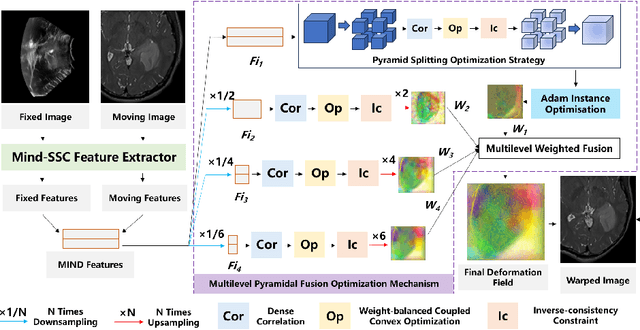
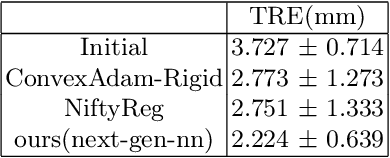
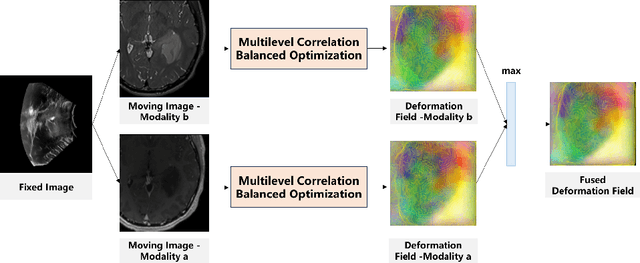

Abstract:Surgical navigation based on multimodal image registration has played a significant role in providing intraoperative guidance to surgeons by showing the relative position of the target area to critical anatomical structures during surgery. However, due to the differences between multimodal images and intraoperative image deformation caused by tissue displacement and removal during the surgery, effective registration of preoperative and intraoperative multimodal images faces significant challenges. To address the multimodal image registration challenges in Learn2Reg 2024, an unsupervised multimodal medical image registration method based on multilevel correlation balanced optimization (MCBO) is designed to solve these problems. First, the features of each modality are extracted based on the modality independent neighborhood descriptor, and the multimodal images is mapped to the feature space. Second, a multilevel pyramidal fusion optimization mechanism is designed to achieve global optimization and local detail complementation of the deformation field through dense correlation analysis and weight-balanced coupled convex optimization for input features at different scales. For preoperative medical images in different modalities, the alignment and stacking of valid information between different modalities is achieved by the maximum fusion between deformation fields. Our method focuses on the ReMIND2Reg task in Learn2Reg 2024, and to verify the generality of the method, we also tested it on the COMULIS3DCLEM task. Based on the results, our method achieved second place in the validation of both two tasks.
Large Scale Unsupervised Brain MRI Image Registration Solution for Learn2Reg 2024
Sep 04, 2024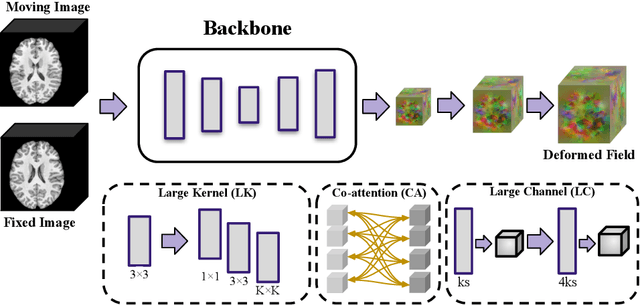


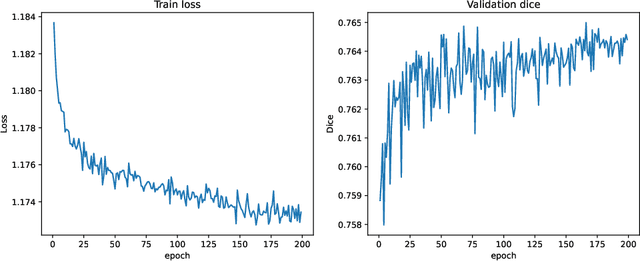
Abstract:In this paper, we summarize the methods and experimental results we proposed for Task 2 in the learn2reg 2024 Challenge. This task focuses on unsupervised registration of anatomical structures in brain MRI images between different patients. The difficulty lies in: (1) without segmentation labels, and (2) a large amount of data. To address these challenges, we built an efficient backbone network and explored several schemes to further enhance registration accuracy. Under the guidance of the NCC loss function and smoothness regularization loss function, we obtained a smooth and reasonable deformation field. According to the leaderboard, our method achieved a Dice coefficient of 77.34%, which is 1.4% higher than the TransMorph. Overall, we won second place on the leaderboard for Task 2.
A Multi-scale Optimization Learning Framework for Diffeomorphic Deformable Registration
Apr 30, 2020



Abstract:Conventional deformable registration methods aim at solving a specifically designed optimization model on image pairs and offer a rigorous theoretical treatment. However, their computational costs are exceptionally high. In contrast, recent learning-based approaches can provide fast deformation estimation. These heuristic network architectures are fully data-driven and thus lack explicitly domain knowledge or geometric constraints, such as topology-preserving, which is indispensable to generate plausible deformations. To integrate the advantages and avoid the limitations of these two categories of approaches, we design a new learning-based framework to optimize a diffeomorphic model via multi-scale propagations. Specifically, we first introduce a generic optimization model to formulate diffeomorphic registration with both velocity and deformation fields. Then we propose a schematic optimization scheme with a nested splitting technique. Finally, a series of learnable architectures are utilized to obtain the final propagative updating in the coarse-to-fine feature spaces. We conduct two groups of image registration experiments on 3D adult and child brain MR volume datasets including image-to-atlas and image-to-image registrations. Extensive results demonstrate that the proposed method achieves state-of-the-art performance with diffeomorphic guarantee and extreme efficiency.
Converged Deep Framework Assembling Principled Modules for CS-MRI
Oct 29, 2019

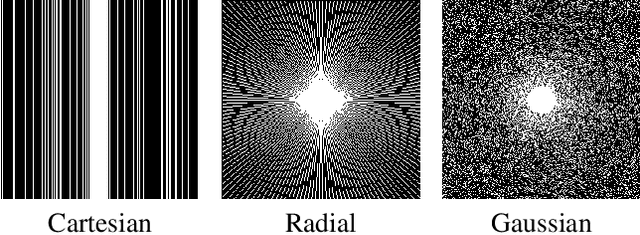
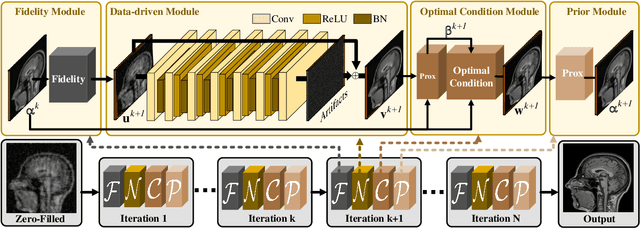
Abstract:Compressed Sensing Magnetic Resonance Imaging (CS-MRI) significantly accelerates MR data acquisition at a sampling rate much lower than the Nyquist criterion. A major challenge for CS-MRI lies in solving the severely ill-posed inverse problem to reconstruct aliasing-free MR images from the sparse k-space data. Conventional methods typically optimize an energy function, producing reconstruction of high quality, but their iterative numerical solvers unavoidably bring extremely slow processing. Recent data-driven techniques are able to provide fast restoration by either learning direct prediction to final reconstruction or plugging learned modules into the energy optimizer. Nevertheless, these data-driven predictors cannot guarantee the reconstruction following constraints underlying the regularizers of conventional methods so that the reliability of their reconstruction results are questionable. In this paper, we propose a converged deep framework assembling principled modules for CS-MRI that fuses learning strategy with the iterative solver of a conventional reconstruction energy. This framework embeds an optimal condition checking mechanism, fostering \emph{efficient} and \emph{reliable} reconstruction. We also apply the framework to two practical tasks, \emph{i.e.}, parallel imaging and reconstruction with Rician noise. Extensive experiments on both benchmark and manufacturer-testing images demonstrate that the proposed method reliably converges to the optimal solution more efficiently and accurately than the state-of-the-art in various scenarios.
Underexposed Image Correction via Hybrid Priors Navigated Deep Propagation
Jul 17, 2019
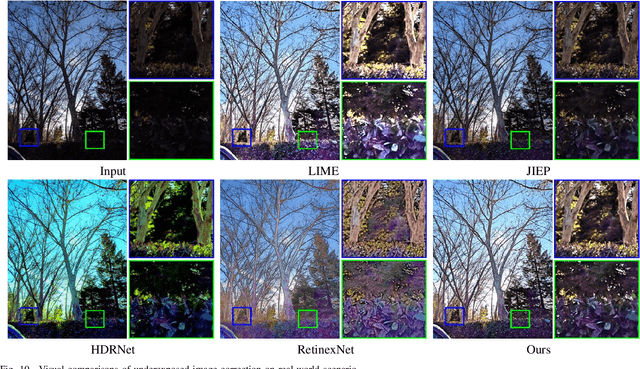

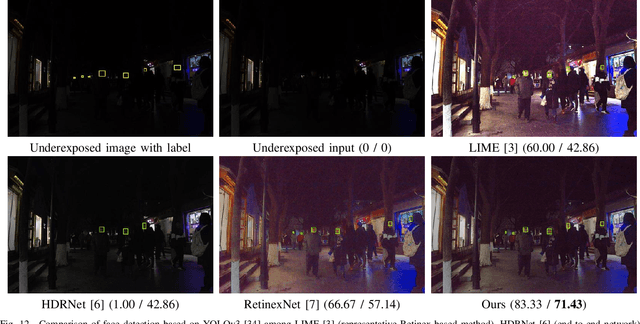
Abstract:Enhancing visual qualities for underexposed images is an extensively concerned task that plays important roles in various areas of multimedia and computer vision. Most existing methods often fail to generate high-quality results with appropriate luminance and abundant details. To address these issues, we in this work develop a novel framework, integrating both knowledge from physical principles and implicit distributions from data to solve the underexposed image correction task. More concretely, we propose a new perspective to formulate this task as an energy-inspired model with advanced hybrid priors. A propagation procedure navigated by the hybrid priors is well designed for simultaneously propagating the reflectance and illumination toward desired results. We conduct extensive experiments to verify the necessity of integrating both underlying principles (i.e., with knowledge) and distributions (i.e., from data) as navigated deep propagation. Plenty of experimental results of underexposed image correction demonstrate that our proposed method performs favorably against the state-of-the-art methods on both subjective and objective assessments. Additionally, we execute the task of face detection to further verify the naturalness and practical value of underexposed image correction. What's more, we employ our method to single image haze removal whose experimental results further demonstrate its superiorities.
A Theoretically Guaranteed Deep Optimization Framework for Robust Compressive Sensing MRI
Nov 13, 2018

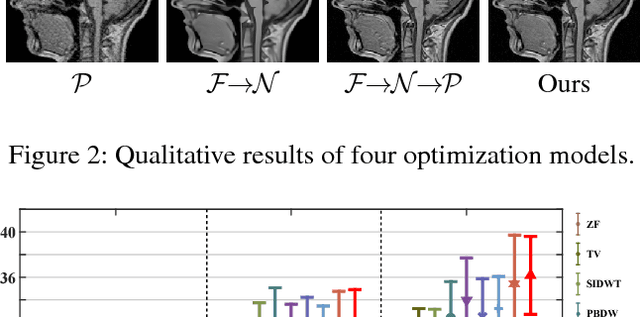

Abstract:Magnetic Resonance Imaging (MRI) is one of the most dynamic and safe imaging techniques available for clinical applications. However, the rather slow speed of MRI acquisitions limits the patient throughput and potential indi cations. Compressive Sensing (CS) has proven to be an efficient technique for accelerating MRI acquisition. The most widely used CS-MRI model, founded on the premise of reconstructing an image from an incompletely filled k-space, leads to an ill-posed inverse problem. In the past years, lots of efforts have been made to efficiently optimize the CS-MRI model. Inspired by deep learning techniques, some preliminary works have tried to incorporate deep architectures into CS-MRI process. Unfortunately, the convergence issues (due to the experience-based networks) and the robustness (i.e., lack real-world noise modeling) of these deeply trained optimization methods are still missing. In this work, we develop a new paradigm to integrate designed numerical solvers and the data-driven architectures for CS-MRI. By introducing an optimal condition checking mechanism, we can successfully prove the convergence of our established deep CS-MRI optimization scheme. Furthermore, we explicitly formulate the Rician noise distributions within our framework and obtain an extended CS-MRI network to handle the real-world nosies in the MRI process. Extensive experimental results verify that the proposed paradigm outperforms the existing state-of-the-art techniques both in reconstruction accuracy and efficiency as well as robustness to noises in real scene.
 Add to Chrome
Add to Chrome Add to Firefox
Add to Firefox Add to Edge
Add to Edge